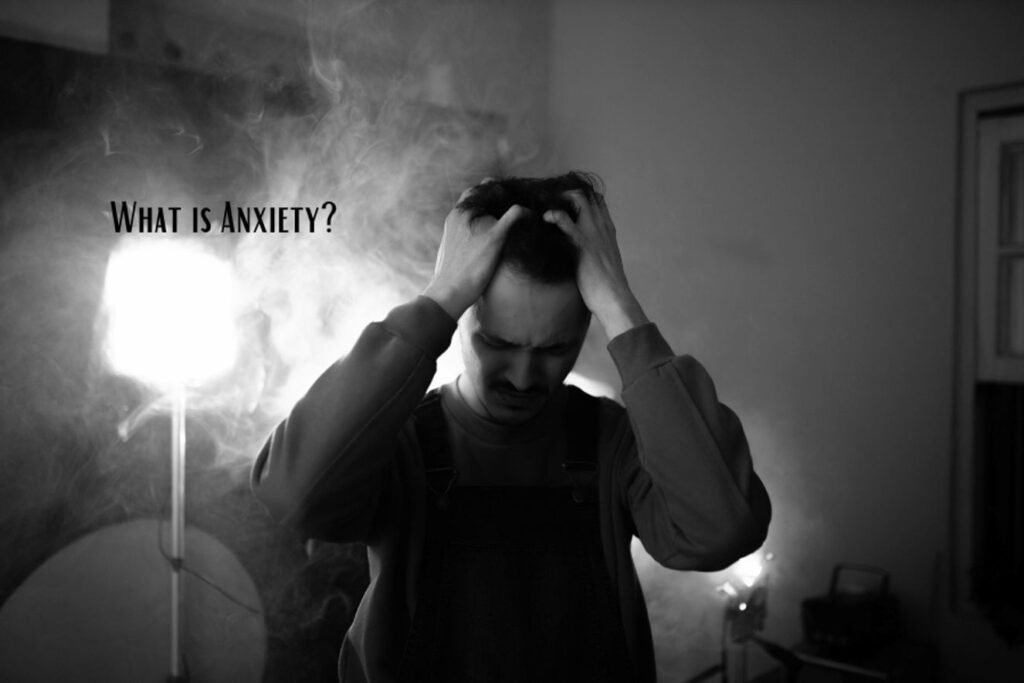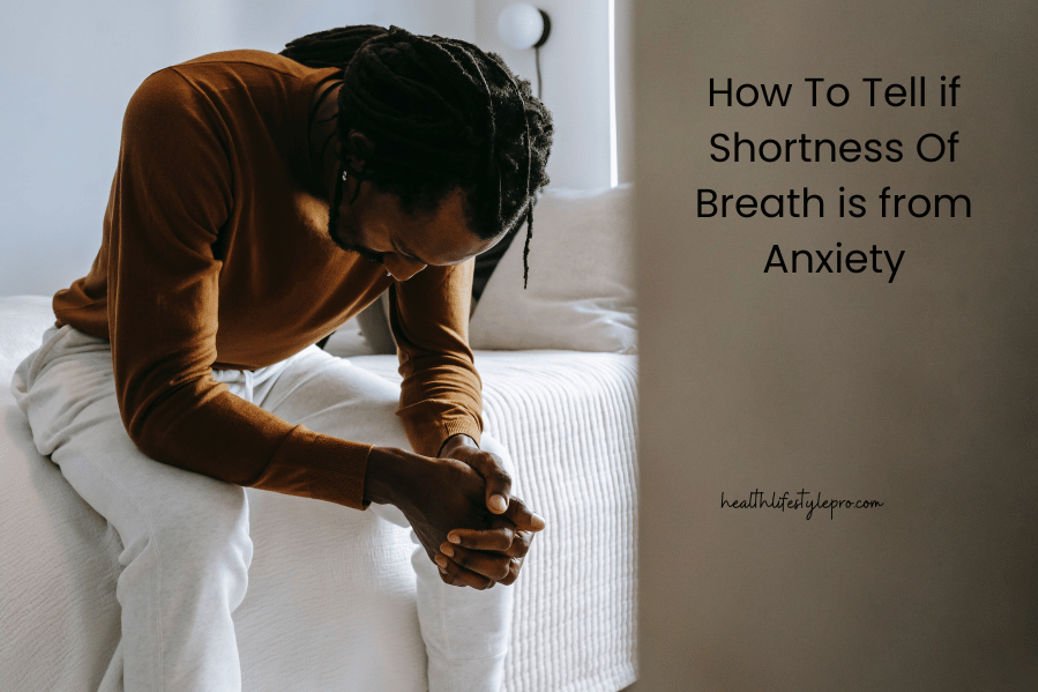Breathlessness is a typical anxiety symptom. Now the question is How To Tell if Shortness Of Breath is from Anxiety Breathlessness can be a result of worry triggered by certain circumstances. Anxiety might also increase with dyspnea.
Upon seeing an anxiety symptom, individuals might think they are experiencing a cardiac or breathing issue.
The connection between worry and dyspnea—a medical term for shortness of breath—is examined in this article. Other potential reasons for dyspnea are also examined.
What is Anxiety?

It’s critical to first comprehend what anxiety is to comprehend how and why it results in dyspnea.
A state of tension that might be physical, mental, or emotional is called anxiety. Symptoms of anxiety or stress include the following:
- Elevated pulse rate and palpitations in the heart
- Breathing difficulties
- tense physique
- Sweating Anxiety
- digestive problems
- Uncontrollably persistent anxieties
- Intolerance
These feelings are natural, protective reactions to a stressful circumstance, while they might understandably feel uncomfortable at times. On the other hand, unexplained worry or worry that is excessive relative to the gravity of an incident or circumstance is a sign of an anxiety disorder.
What causes shortness of breath from Anxiety?
Fear is commonly linked to anxiety and panic. These may result in physical and behavioral changes that get the individual ready to protect themselves against an aggressor.
An instinctive fight-or-flight response is the brain’s response to terror. The muscles are primed for action as the heart rate rises to pump blood to the organs more quickly.
Provide the muscles with more oxygen, it also makes a person breathe faster. Breathlessness may be the outcome.
How to determine if anxiety is the cause
Identifying whether symptoms of anxiety are caused by anxiety itself or by another health problem can be challenging when one is feeling anxiety. When the symptoms are serious, this can be particularly difficult.
Breathing difficulties are not a common sign of anxiety, although it might happen to some individuals.
Numerous physical and psychological symptoms, such as the following, can be caused by anxiety: Reliable Source:
- dry tongue and elevated heart rate
- lightheadedness
- chills and perspiration
- nausea
- constipation trembling tense muscles fast respiration
- anxiety and chest pain
- trouble speaking, inability to focus, disorientation, and poor remembering
How to get rid of breathlessness
Although Darnley concurs that it’s usually better to be safe than sorry, she suggests that people who are having trouble breathing for unclear reasons “seek urgent care if you are unsure as to whether your shortness of breath is due to anxiety or a medical concern;” if they are certain that their shortness of breath is caused by anxiety, they can take steps to help their body relax.
“Remember yourself that it will pass and acknowledge that it is not a medical emergency,” she advises as a first step. regulating breathing by inhaling deeply, breathing into a paper bag, or laying one’s hands over one’s chest to feel each breath coming in and leaving out.
Above all, to stop such triggers from happening more frequently, it’s critical to address whatever underlying worry led to the episode. Experts can also offer tailored advice on how to go through it more quickly. “Psychologists and other specialists will help teach you relaxation techniques and coping skills that will enable you to confront the triggers,” Darnley writes.
Practices for deep breathing
The sympathetic nervous system (fight-or-flight response) in balance with the parasympathetic nervous system (rest) controls heart rate, which is directly impacted by breathing. That’s why using deep breathing exercises to help center yourself might be a useful way to reduce anxiety symptoms.
Treatments
- Doctors can offer various treatments for anxiety, such as medications, psychotherapy, or a combination.
- Interventions
- Psychotherapy, medicine, or a combination of the two are among the therapies for anxiety that doctors can provide.
- Drugs
- Benzodiazepines are sometimes prescribed by doctors to treat anxiety symptoms, including dyspnea.
These medications, which include alprazolam (Xanax), clonazepam (Klonopin), diazepam (Valium), and lorazepam (Ativan), may offer some relief from anxiety symptoms in about half an hour.
Yet, there are negative consequences associated with benzodiazepines. The Food and Drug Administration updated its benzodiazepine warning in 2020. Drug withdrawal symptoms can be fatal, and these substances can cause physical dependence. Death may ensue from combining them with opiates, alcohol, and other drugs. When taking these medications, it’s imperative to do as directed by your doctor.
In addition, doctors may recommend selective serotonin reuptake inhibitors, usually known as antidepressants or SSRIs, to treat anxiety symptoms.
Techniques for relaxation
To ease anxiety and enhance breathing, people can benefit from practicing at-home relaxation techniques.
breathing using the diaphragm
Diaphragmatic breathing is a potentially effective instant treatment for anxiety-related dyspnea.
To breathe diaphragmatically:
Reposition yourself comfortably on a flat surface. With one hand on the diaphragm, just below the ribs and above the stomach, and the other in the middle of your chest, breathe in slowly through your nose, allowing the diaphragm to expand. Your upper hand should stay still, but your lower hand should rise. Contract your abdominal muscles and slowly exhale. Repeat. Patients who practice it indicate that it helps them maintain emotional equilibrium, and some doctors recommend it to assist in lowering anxiety. According to a 2017 study, people who practice diaphragmatic breathing for 20 sessions report feeling less stressed and depressed. The individuals were not diagnosed with anxiety, though.
Tight lip breathing
Breathing slowly and using pursed lips can help someone who is having trouble breathing get relief. The goal of the practice is to become more deliberate with every breath.
To breathe with pursed lips:
- comfortably stand or sit.
- two seconds of inhaled air through the nose
- Tightly purse your lips, then take a four-second deep breath out through them.
- once more
Put on your best music
Occasionally, a small diversion can help your brain when you’re anxious. Easing your anxiety and any accompanying physical symptoms (such as shortness of breath) can be achieved by turning off your thoughts with music, even your favorite song.
Feeling anxious and unsure of where to begin?
To begin treating anxiety, make an appointment with a licensed healthcare provider, such as a primary care physician, therapist, or psychiatrist. help you feel better, they will be able to perform a comprehensive evaluation, offer a diagnosis, and go over available treatments.
Take our quick and free exam to discover if Talkiatry is a suitable fit for you if you think you may have an anxiety illness such as generalized anxiety disorder, or if you’re not sure. You may also use this tool to find a psychiatrist who accepts your insurance and who matches your needs.
What does shortness of breath from anxiety feel like?
Shortness of breath from anxiety often feels like a tightness or restriction in the chest, making it difficult to take deep breaths. Individuals may experience a sensation of not getting enough air, leading to a heightened awareness of their breathing. It can be accompanied by a rapid heartbeat, dizziness, and a sense of impending doom. The breathing may become shallow and rapid, contributing to a feeling of breathlessness. People with anxiety-induced shortness of breath may also hyperventilate, exacerbating their symptoms. Overall, it creates a distressing and uncomfortable sensation, often linked to the body’s “fight or flight” response triggered by anxiety.
What is the 3 3 3 rule for anxiety?
The 3-3-3 rule is a technique used to manage anxiety and regain a sense of control. It involves acknowledging three things you can see, three things you can hear, and three things you can touch in your immediate surroundings. By grounding yourself in the present moment, this exercise helps shift focus away from anxious thoughts. It encourages mindfulness and engagement with the sensory aspects of the environment. The simplicity of the rule makes it easily applicable in various situations, providing a quick and effective way to break the cycle of anxiety. Practicing the 3-3-3 rule can help individuals regain composure and manage overwhelming emotions, fostering a sense of calm and stability.
Why am I constantly thinking about my breathing?
Constantly thinking about your breathing could be due to various reasons, with anxiety being a common factor. Heightened anxiety can lead to increased self-awareness and a focus on bodily functions, such as breathing. This hyperawareness may create a feedback loop, where the more attention you give to your breath, the more it becomes a conscious and potentially distressing thought. Health concerns or a history of respiratory issues could also contribute to this preoccupation with breathing. In some cases, it may be a symptom of conditions like obsessive-compulsive disorder (OCD) or panic disorder. Additionally, stress and a busy mind can lead to an automatic fixation on something as fundamental as breathing. It’s essential to explore the root cause with a healthcare professional or mental health expert to address and manage this persistent preoccupation effectively.
How do I stop air hunger from anxiety?
| Strategy | Description |
|---|---|
| Deep Breathing | Practice slow, deep breaths to engage your diaphragm and promote relaxation. Inhale deeply through your nose and exhale slowly through your mouth. |
| Grounding Techniques | Use grounding exercises, such as the 3-3-3 rule, to shift your focus away from the sensation of air hunger and onto your immediate surroundings. |
| Progressive Muscle Relaxation | Systematically tense and then release different muscle groups in your body to reduce overall tension and promote a sense of calm. |
| Mindfulness Meditation | Incorporate mindfulness meditation to stay present and non-judgmentally observe your thoughts and sensations, helping to break the cycle of anxious thinking. |
| Cognitive Behavioral Therapy | Work with a therapist to identify and challenge negative thought patterns associated with air hunger, replacing them with more realistic and positive perspectives. |
| Relaxation Techniques | Explore various relaxation techniques, such as guided imagery or listening to calming music, to create a soothing environment and alleviate anxiety-related air hunger. |
| Consult a Healthcare Professional | If symptoms persist or worsen, consult a healthcare professional or mental health expert for a thorough assessment and personalized guidance on managing anxiety and air hunger. |
Final Thoughts: How To Tell if Shortness Of Breath is from Anxiety
Anxiety or panic attacks that produce dyspnea can exacerbate the person’s anxiety, which in turn can aggravate breathing.
To assist in reducing this and other anxiety symptoms, doctors frequently suggest diaphragmatic breathing and relaxation methods.
A temporary pharmaceutical regimen to manage anxiety symptoms is also beneficial for certain individuals. Psychotherapy and medicine may be necessary to treat panic and chronic anxiety.

I’m a seasoned content creator with 6+ years of experience crafting engaging, SEO-optimized content that drives traffic and rankings. I excel in keyword research, link building, and guest posting, ensuring your brand reaches new heights.

